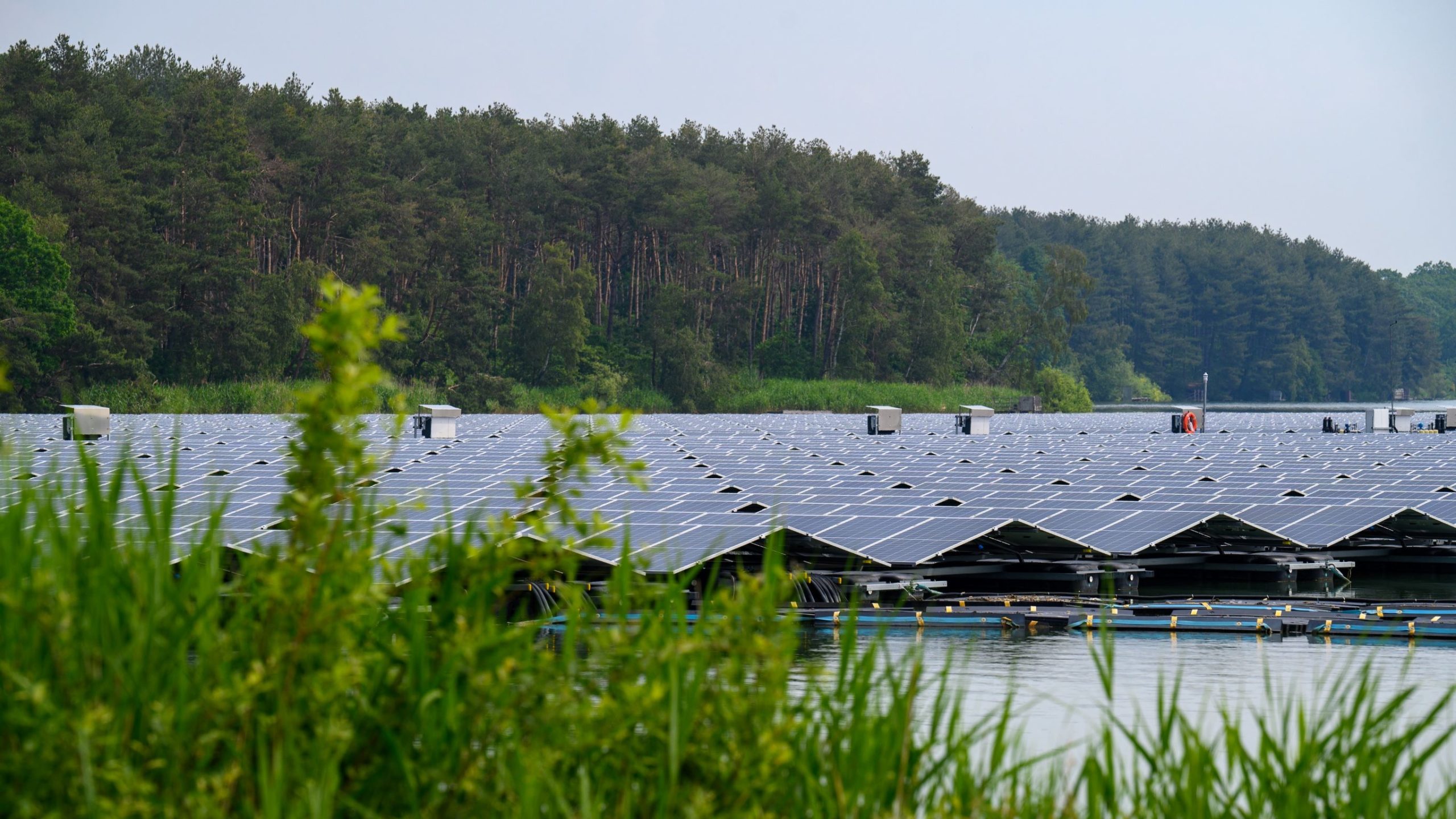 A drop in the bucket, but heavily subsidized: A floating solar park in Dessel, Belgium, Antwerp province. In the immediate vicinity is the FGFC company, which belongs to the French nuclear group Areva and manufactures fuel elements for pressurized water reactors; as well as the “Study Center for Nuclear Energy” with its research reactors. Has the climate future already begun here, and will the idyllic solar park soon look old? (Image: EC - Audiovisual Service)
A drop in the bucket, but heavily subsidized: A floating solar park in Dessel, Belgium, Antwerp province. In the immediate vicinity is the FGFC company, which belongs to the French nuclear group Areva and manufactures fuel elements for pressurized water reactors; as well as the “Study Center for Nuclear Energy” with its research reactors. Has the climate future already begun here, and will the idyllic solar park soon look old? (Image: EC - Audiovisual Service) After the huge spending injections concerning real or claimed COVID damage, the two major economies are now once again donating hundreds of billions, which are intended to undermine weaknesses in the industries of both sides. In addition, everything good and beautiful, above all the climate and the technology aimed to support it is promoted. But if you look closely, you can make out backdrops in both places that are nimbly shifted back and forth to amaze the audience.
American Industrial Policy: State Money and a Smorgasbord of Colorful Dreams
The U.S. is riding on two tracks, one of which is fairly straightforward. A “Chips and Science Act” is supposed to promote the development and production of the latest chips with 280 billion dollars in subsidies. The point of this is directed against China: The support keeps the American chip industry in line because it is banned from many exports to China. The whole thing is already picking up, with the industry announcing $300 billion worth of new production projects. There is nothing better at the moment than being the boss of such a company—coddled by the government, showered with billions.
On the second track of American industrial policy, there runs the “Inflation Reduction Act,” a huge convoy of the most colorful dreams. The train is said to be worth 738 billion dollars. A good half of this amount goes to subsidies of all kinds for climate technologies, for energy promotion, for cutting-edge production techniques and for more environmentally friendly agriculture. In it one might even find “racial equity in farming.” Not quite the other half is supposed to help miraculously reduce the massive and still increasing budget deficit, with programs for cheaper drugs, hospitals, and all with the help of tax reforms.
Conservative think tanks, on the other hand, predict job losses, and the Congressional Budget Office says there is “no discernible impact on inflation.” But that was the whole point, as the name “Inflation Reduction Act” suggests!
The 738 billion costs will be financed with again cheaper drugs at the expense of government support programs (so they work on both sides, in spending and savings—wonderful!), with a 15% super tax on large companies, a one percent levy on share buybacks. In addition, there is a huge backdrop of savings of 181 billion dollars thanks to more efficient tax collection. The latter has figured in all U.S. programs for years but seems to reconsidered again and again, because it never works.
But all this is supposed to work—according to the advocates of the programs and scholarly studies on them—with huge budget savings over 20 years (say left-wing studies) and 1.4 million jobs (say studies by Greens). Conservative think tanks, on the other hand, predict job losses, and the Congressional Budget Office says there is “no discernible impact on inflation.” But that was the whole point, as the name “Inflation Reduction Act” suggests!
The EU’s Fiscal Counterattack
The EU is now launching a fiscal counterattack, expressly as a reaction to the American subsidy machine. On February 1, Commission President von der Leyen and a flurry of communications from Brussels announced the “Green Deal Industrial Plan.” This plan uses all the buzzwords that sound chic and English. The intention is to prepare industry for the Net Zero goal, with an enormous set of rules for projects, strategies and websites. Access to the big money is to be accelerated by redirecting previous EU funds—a backdrop shift on a larger scale. For the far too many funds from the former “Resilience and Recovery Facililty” of many hundreds of billions— most of which are still lying dormant in accounts or have yet to be absorbed—are to be finally released and “as a matter of priority”—immediately, with concrete plans by the member states through April 30, 2023.
So that the success of the programs can be demonstrated, the money now has to go by the truckload. Windfall effects, bungling, and abuse are the result.
Then everything nice continues to be promoted—vocational training, supply chains, rare earths, production to be returned to Europe, and everything is to be innovated with international partners. But woe betide if others “act unfairly” with their industrial aid—then the border closes. This has already been threatened. From now on, the EU itself will care little about such protectionist measures, because at the same time, with the billions of euros, the barriers to state aid will also be greatly relaxed. Only temporarily, of course, as they say.
Rashness and Delusions of Grandeur
The assessment of both series of programs, that of the USA as well as that of the EU, must be scathing. On the one hand, megalomania reigns—these enormous sums can hardly be absorbed by the administrations distributing them and the companies receiving them. By the end of 2022, Italy, for example, will have managed to complete just 29 billion projects out of the 190 billion euros in aid promised earlier by the EU.
Secondly, companies will simply submit projects that they are already planning so they can receive the corresponding donations from the EU coffers. Anyone who, in accordance with the “methodological individualism” of the Austrian school of economics, imagines how a company will react to such sums and deadlines must be aware that such deadweight effects will be part of the normal course of events. Because with urgency, such as the April 30, 2023 deadline for submitting modified plans for implementing the so-called REPowerEU measures, the bureaucrats are putting not only the states and the companies under deadline pressure, but themselves: so that the success of the programs can be demonstrated, the money now has to go by the truckload. Windfall effects, bungling, and abuse are the result.
But now the central banks of both currency areas are announcing permanently higher interest rates and want to throw previously purchased government securities onto the market. This will soon bring disastrous distortions.
Third, all Western European countries and the USA are in severe budget deficits. The U.S. still borrows a quarter of government spending, even before the new spending wave; Italy’s deficit is 14% of spending. The debt in southern Europe and the U.S. is enormous. But now the central banks of both currency areas are announcing permanently higher interest rates and want to throw previously purchased government securities onto the market. This will soon bring disastrous distortions—either the central banks cave in and inflation continues to rage, the states go bankrupt, or they strangle all spending and become ungovernable under street pressure.
Backdrop Shifting as a Way Out?
In both currency areas, the politicians are playing tricks, and in the end, only a small part will be put on the rails. Only the chip program in the USA will probably go ahead. In Europe, on the other hand, there will be many sluggish companies that will have become accustomed to hanging on the government’s coattails—but still no cutting-edge microchips.
And everything has been done before: The backdrop shifting was already tested in the EU in 2015: the grandly announced Juncker plan was supposed to attract money from the investment bank with its mere 5 billion, and 16 billion from the EU budget were meant to trigger investments amounting to 315 billion. The EU Court of Auditors later soberly noted that only a good 100 billion had flowed in total, but that there had also been many windfall effects—i.e., money for things that were already planned as well as for things that were unnecessary.
The worst thing, however, is how Western economies use their political dreams to undermine the market economy and thus prevent privately stimulated innovation.
The EU also made industrial policy with its stubborn adherence to the postal monopolies until 1998, while the U.S. broke up the telephone monopoly as early as 1982 and all of today’s huge companies for communications, chips and networks got their start there—often by young boys in a garage, not with government billions. The EU gave them a full 16-year head start. That, too, is industrial policy—by bureaucrats.
The worst thing, however, is how Western economies use their political dreams to undermine the market economy and thus prevent privately stimulated innovation. The result will not be better research departments, but gigantic staffs in these companies for “public affairs” and “regulatory compliance” to absorb and process this windfall. In addition, there will be rich shareholders and the fiscal ruin already mentioned. Even if only part of this scenario becomes reality: delusions of omnipotence will in any case remain.



